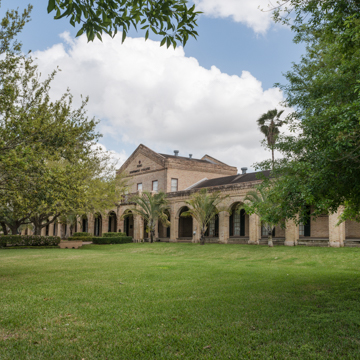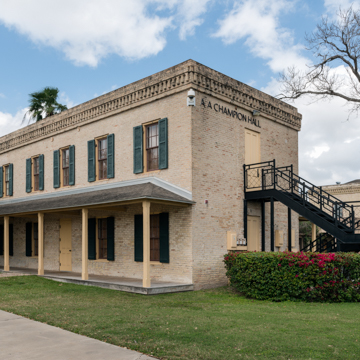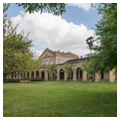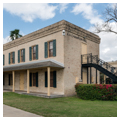Fort Brown is the oldest military outpost of the United States–Mexico border. It dates to the arrival of General Zachary Taylor at the Rio Grande in March 1846 to claim the southern tip of Texas as American land. Earthen fortifications, named Fort Texas, were immediately erected by Taylor and his men on the north bank of the river opposite Matamoros. That move initiated the Mexican War with battles at Resaca de la Palma and Palo Alto at the northern limits of present-day Brownsville. Palo Alto Battlefield is a National Historic Site managed by the National Park Service.
Following the American victory, Fort Brown was relocated west, flanking the eastern side of Brownsville and encompassing within its boundaries an oval-shaped resaca with a twenty-five-acre island designated as a military cemetery. Fort Texas, with its six bastions, was abandoned and left as a memorial to Major Jacob Brown, the first officer to die in battle in the war, and the namesake of the new city and fort. Today, earthen mounds denote the old fort at the northwest corner of the Fort Brown Municipal Golf Course with a large upright cannon erected in 1920 on the spot where Brown fell.
After suffering significant damage during occupation by both Union and Confederate troops, Fort Brown, like all other border outposts, was substantially improved in the late 1860s. It was at that time that the fort was moved north and built at its current location following standard military plans, with extensive parade grounds laid out on a northeast–southwest axis. Similar to Fort Ringgold ( SM30), Fort Brown was decommissioned in 1944 after ninety-eight years of service, and sold to local government as a venue for civic and educational facilities. But unlike Ring-gold, the majority of Fort Brown's historic resources did not survive to the present day, including its cemetery and its imposing headquarters building.
The parade grounds were used to build the modernist Fort Brown Memorial Center (1954), at 600 International Boulevard, by Dallas-based architects Wilshire and Fisher. The sunken gardens, outdoor lobby, and walled courtyards of the facility were intended to recall the historic architecture of the border.
Fortunately, the post's hospital (1869), at 1825 May Street, survives today as the administration building of Texas Southmost College. Rehabilitated in 1991 by Austin architect David Hoffman, the standardized military hospital design incorporates local building traditions with its buff brick construction, and has a full-perimeter round-arched gallery subdivided by raised pilasters in support of a classical entablature that reflects the Border Brick style.
Behind the hospital, and also dating to 1869, the two-story post hospital's annex and the diminutive morgue building remain, as well as the 1905 commissary that was rehabilitated in 1989 by Hoffman as the art building for the college. In the 1990s, a concerted effort was made to organize the campus by means of a linear paseo, or pedestrian mall, which collects the disparate historic structures of the old fort and the new facilities that take their visual cue from the Border Brick style.













